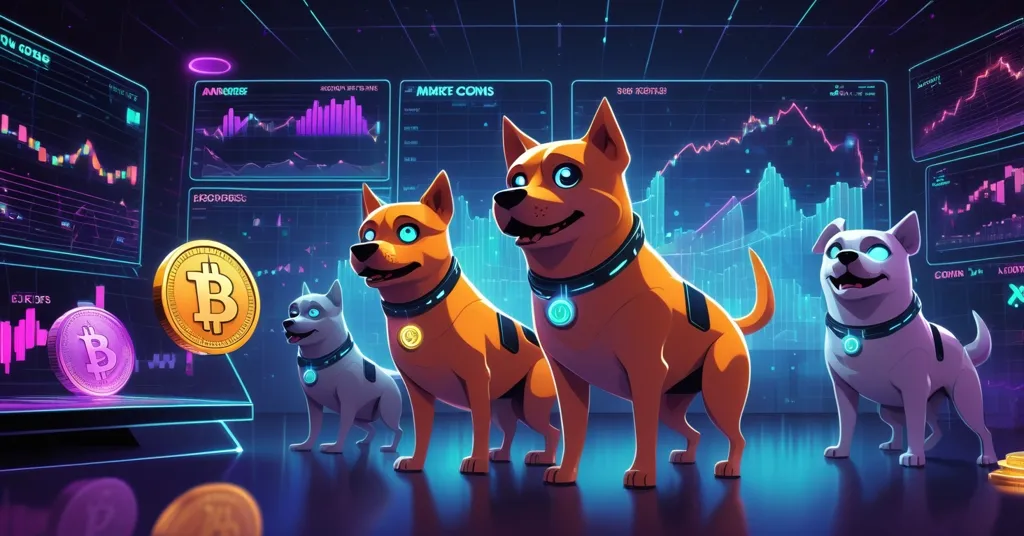Grok AI Meme Coin Predictions for 2026: Dogecoin, Shiba Inu, and Little Pepe Hype Analyzed

Grok AI Meme Coin Price Predictions 2026: Dogecoin, Shiba Inu, and Little Pepe Hype Under the Microscope
Buckle up, crypto enthusiasts—Grok AI has rolled out some head-turning price predictions for meme coins Dogecoin, Shiba Inu, and a fresh face, Little Pepe (LILPEPE), with promises of massive gains by 2026. But are these forecasts a glimpse into the future or just another dose of speculative nonsense? Let’s dissect the hype, the risks, and the reality behind these bold claims in the chaotic meme coin arena.
- Dogecoin to $1 by April 2026: A 5x leap from its current $0.20, banking on adoption and Bitcoin’s bull run momentum.
- Shiba Inu to $0.0001 by late 2025: A 7.5x surge from $0.0000134, pegged to ecosystem growth like Shibarium.
- Little Pepe to $3 by Q2 2026: A staggering 2,042x gain from a presale price of $0.0014, fueled by presale buzz and lofty tech promises.
Dogecoin: Riding Bitcoin’s Wave to $1?
Dogecoin, the original meme coin that barked its way into the spotlight, sits at around $0.20 today. Grok AI predicts it’ll hit $1 by April 2026, a 5x jump that would push its market cap to roughly $145 billion from the current $29 billion. That’s like valuing a joke currency above many Fortune 500 companies—possible in a manic bull run, but a hell of a stretch. The forecast hinges on increased adoption, integration into payment systems, and momentum spilling over from Bitcoin’s market surges, especially after the 2024 halving. Historically, Dogecoin has piggybacked on Bitcoin’s bull cycles, and with occasional hype from figures like Elon Musk teasing DOGE for tips or transactions, a big spike isn’t entirely far-fetched, as seen in its price history.
But let’s not get carried away. Dogecoin’s value is almost purely speculative, lacking the bedrock utility of Bitcoin as sound money or Ethereum’s smart contract prowess. Without real-world moves—like Twitter actually making DOGE a payment option—this prediction is more meme than math. If Musk ever puts his money where his tweets are, DOGE might surprise us. Until then, it’s a gamble dressed up as a good boy.
Shiba Inu: Can Shibarium Spark a 7.5x Surge?
Shiba Inu, the self-styled “Dogecoin killer,” is currently priced at a meager $0.0000134. Grok AI sees it climbing to $0.0001 by late 2025, a 7.5x return that would lift its market cap from $7.9 billion to over $50 billion. The driver? Ecosystem growth, particularly Shibarium, a Layer 2 scaling solution launched in 2023. For those new to the term, think of Layer 2 as an express lane on a crowded highway—it handles smaller transactions off the main Ethereum blockchain to keep things fast and cheap. Shibarium has processed over 400 million transactions since launch, a solid sign of activity, with community discussions highlighting its potential impact on price.
Add to that Shiba Inu’s token burn mechanics—where a portion of coins are destroyed forever, like shredding dollar bills to make the rest rarer—and there’s a case for price growth in a frothy market. But can a meme coin truly build lasting value, or is this just another flash in the pan? Reaching $0.0001 assumes relentless community hype and engagement, both of which can evaporate overnight in this space. SHIB has survived bear markets, unlike most meme coins, but without deeper utility, this forecast feels like betting on a TikTok trend to last a decade.
Little Pepe: Presale Hype or Total Flop?
Now we enter the wild west with Little Pepe (LILPEPE), a presale project that’s got Grok AI drooling over a $3 price tag by Q2 2026. That’s a mind-boggling 2,042x gain from its Stage 5 presale price of $0.0014—turn $1,000 into over $2 million in under two years if you buy the pitch. The project has raised over $5.9 million, sold 4.9 billion tokens, and boasts a listing price of $0.003, offering a 2.14x return for early birds. It’s listed on CoinMarketCap for visibility, claims an audit score of 81.55 from Freshcoins.io, and dangles a shiny carrot: a $777,000 giveaway where 10 winners snag $77,000 in tokens each, provided you invest at least $100 and do some social media song-and-dance. Oh, and they’re promising a Layer 2 blockchain for fast, low-cost transactions. Sounds like a jackpot, right? But how do you even verify its legitimacy? Insights on platforms like Quora discuss presale risks that are worth considering.
Wrong. This reeks of speculative frenzy and classic bait-and-switch tactics. The meme coin graveyard is packed with projects that raised millions only to rug-pull or fade into oblivion—over 90% of tokens launched between 2021 and 2023 lost nearly all value within 18 months, per CoinGecko data. CoinMarketCap listings can be bought, and audit scores from lesser-known platforms aren’t always worth the pixels they’re displayed on. The Layer 2 claim is sexy but unsubstantiated—no whitepaper, no timeline, no proof of progress. Compare that to Shibarium’s tangible 400 million transactions, and LILPEPE’s tech talk looks like vaporware. The giveaway? It’s a tired presale trick to hook retail investors, often masking a void of substance. A 2,042x return would demand a market cap in the tens of billions from scratch—a feat even Dogecoin needed years and celebrity clout to approach. For a deeper look at its credibility, check the audit scores and scam reports surrounding Little Pepe.
Let’s play devil’s advocate for a second. If—and it’s a massive if—the team behind Little Pepe delivers a functional Layer 2 and builds a genuine community, could it defy the odds? Stranger things have happened in crypto. But without transparency on tokenomics, like team allocations or vesting schedules, and with zero track record, this smells like the Squid Game token fiasco of 2021 all over again, where hype led to a $3.38 million rug pull. If you’re tossing cash at LILPEPE, you’re not investing—you’re playing crypto roulette.
Who or What is Grok AI, Anyway?
Before we go further, let’s address the soothsayer behind these predictions: Grok AI. What is it, exactly? Details are murky at best. It’s positioned as an AI tool making crypto forecasts, but there’s no public dataset, algorithm breakdown, or track record to scrutinize. Without transparency, these predictions are as trustworthy as a horoscope—fun to read, but hardly actionable. In a space already drowning in hype, taking Grok AI’s word as gospel is about as smart as trusting a random Twitter thread for financial advice. If we’re to believe Dogecoin will 5x, Shiba Inu will 7.5x, or Little Pepe will 2,042x, we need more than blind faith in an opaque black box. Show us the receipts, or it’s just noise. For community takes on its trustworthiness, explore discussions about Grok AI’s prediction reliability.
The Bigger Picture: Meme Coins in a Bitcoin World
Zooming out, the timeline for these predictions—2025 to 2026—fits neatly into expectations of a post-Bitcoin halving bull run. Historically, after halvings (like the one in 2024), altcoins and meme coins often go parabolic before nosediving back to earth. Dogecoin and Shiba Inu have weathered bear markets and retain loyal communities, giving them a fighting chance at riding that wave. Little Pepe, drenched in presale gimmicks with no organic base, lacks that resilience. Compare it to other meme coins like Kendu, reportedly hitting a $280 million market cap with a tight-knit holder base and real-world branding efforts like energy drinks. Community strength is everything in this niche, and LILPEPE’s reliance on giveaways over grassroots support is a glaring red flag. For broader insights, Reddit discussions on recent meme coin trends shed light on projects like these.
As someone who champions decentralization and disruption, I’ll admit meme coins have a quirky charm. They build communities, drive engagement, and experiment in ways Bitcoin doesn’t. But let’s be real: every dollar chasing a 2,000x meme coin fantasy is a dollar not securing Bitcoin’s network or pushing for true financial freedom. Bitcoin remains the king of sound, censorship-resistant money—its dominance at over 50% of crypto market share speaks volumes. Meme coins are a sideshow, not the revolution. And while altcoins and meme tokens fill chaotic niches, the unbridled shilling around projects like Little Pepe is the kind of garbage that stains crypto’s reputation. We’re here to drive adoption, not peddle pipe dreams.
Risks You Can’t Ignore: Volatility, Scams, and Regulatory Heat
Let’s not mince words: the meme coin market is a damn minefield. Volatility is off the charts—Dogecoin and Shiba Inu have seen 80-90% drops in bear markets, and unproven tokens like Little Pepe could crater to zero overnight. Scams and rug pulls are rampant; the 2021 Squid Game token debacle saw investors lose millions in hours. Regulatory scrutiny is tightening too—the SEC has been cracking down on unregistered securities since 2021, and meme coins often skate dangerously close to that line. A project like LILPEPE, with its presale structure and grandiose promises, could easily catch legal heat, leaving investors holding an empty bag. Learn more about these dangers with resources on meme coin volatility and scam risks.
What’s Next for Meme Coins?
Looking ahead, meme coins will likely remain a volatile playground within the crypto space. Regulatory headwinds could intensify, especially for presale projects that smell like unregistered securities. On the flip side, community-driven tokens with genuine engagement or quirky utility—think Dogecoin’s tipping culture or Kendu’s branding plays—might carve out staying power. But the boom-bust cycle isn’t going anywhere. As Bitcoin’s halving cycles continue to drive market sentiment, we’ll see periodic meme coin frenzies. The question is whether projects like Little Pepe can survive the inevitable correction—or if they’re just the next batch of roadkill on crypto’s highway. For a deeper dive into Grok AI’s forecasts, check out analyses like this prediction breakdown for 2026 targets.
Meme Coins vs. Crypto’s True Mission
So, where do we stand? Meme coins can dazzle with promises of quick riches, but Bitcoin’s quiet strength as decentralized money remains the real revolution worth betting on. While Dogecoin and Shiba Inu have their fans and fleeting potential, and Little Pepe spins a seductive yarn of 2,000x gains, the heart of crypto beats for freedom, privacy, and disrupting the status quo—not gambling on viral jokes. Bitcoin’s mission to be sound, censorship-resistant money trumps speculative plays any day. If you’re lured by these meme coin predictions, keep a few sats of BTC as your safety net. The future of finance isn’t built on hype—it’s built on unshakable code and decentralized power. Curious about Grok AI’s forecasting track record? Explore more on its methodology and credibility.
Key Takeaways and Questions
- What are Grok AI’s price predictions for Dogecoin, Shiba Inu, and Little Pepe?
Dogecoin is forecasted to reach $1 by April 2026, Shiba Inu to hit $0.0001 by late 2025, and Little Pepe to soar to $3 by Q2 2026, promising massive speculative returns. - What factors are driving the potential growth of Dogecoin and Shiba Inu?
Dogecoin’s rise is tied to adoption, payment integrations, and Bitcoin market surges, while Shiba Inu’s growth relies on ecosystem developments like the Shibarium Layer 2 solution. - Why is Little Pepe generating buzz, and should we trust the hype?
Little Pepe’s $5.9 million presale, promised Layer 2 tech, and $777,000 giveaway fuel attention, but unproven claims and lack of transparency make it a risky speculative bet at best. - How reliable are Grok AI’s predictions in the crypto space?
Their reliability is dubious—Grok AI’s methodology is completely opaque, rendering these forecasts more speculative entertainment than actionable insight. - What are the major risks for crypto enthusiasts eyeing meme coins?
Extreme volatility, high likelihood of scams or rug pulls, regulatory crackdowns, and a lack of fundamental value are critical dangers, especially with untested projects like Little Pepe.



